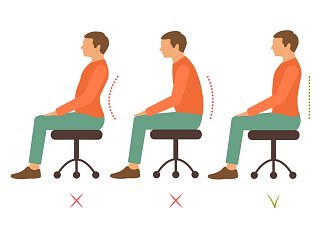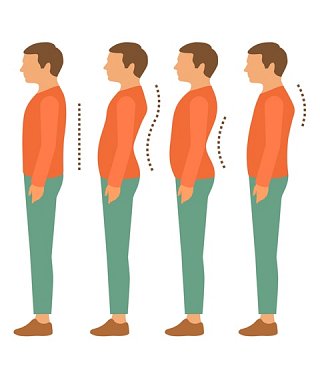Posture Pictures

I would like to share with you some pictures of posture types that I see when treating back pain in my Physiotherapy clinic, as I feel that that is a really useful way to illustrate what good posture actually is.
Very few of us have a perfect posture. This is due to the type of posture we are born with - which combines with our personalities and the movement habits that we adopt over the years.
I myself had severe back pain, and it was through posture correction and back strengthening exercises that I eventually eliminated back pain from my life. Understanding your posture - and how you can change it- is an important step toward maintaining an active posture to prevent back pain.
Sponsored links
In my own practice, I focus on aspects of posture that we can change and improve to help address underlying causes of back pain, and to prevent further episodes of back and neck pain, particularly when the cause is down to poor postural habits.
The following are provide some simple illustrations that show the comparison between good and bad posture habits when sitting and standing:

Correct Sitting Posture
I always encourage people to maintain an active sitting posture, and what I mean by that is you should aim for the back of the head, mid back and hips to all be in a vertical line, as illustrated in the right of this picture. Avoid slouching or leaning forward. If you sit in the same chair for long periods of time, for example at a desk job, then you should ensure that the chair and desk are ergonomically set up. Read more about an active sitting posture here..

Correct Standing Posture
Standing tall is the key! When standing correctly, imagine a line running vertically up from the ankle to which the knee, hips, shoulder and your ear lobe are all aligned, or ‘Head over heart over hips!’ as I say to my clients! The imagine a helium balloon tied to the top of your head, lengthening you towards the ceiling.
Not only standing is it good for your back and overall health it is good for your state of mind - it reinforces a positive and more confident attitude. A good standing posture also helps you come across as a healthier, happier and more confident person - look at the picture at the top of this article as an example and you will see what I mean.
What may not be evident from the above pictures is how your posture can change from bad to good within minutes of good instruction from a Physiotherapist combined with your understanding and awareness of the changes required. Actively maintaining that good posture becomes the challenge.
When I work with my own clients on posture correction, I then advise them to start specific posture exercises. These may be to improve flexibility and to strengthen postural muscles. As a qualified Pilates instructor, I favour Pilates exercises for this purpose. This helps them to strengthen the back to help maintain an active posture in the long term. As a result, the effort of posture correction gets easier and more automatic over time.
DISCLAIMER
While the content and materials contained in the articles on this website have been written & researched by Sally Ann Quirke, a professional, practising & fully qualified Chartered Physiotherapist (Physical Therapist) based in Ireland, they are provided for general information and educational purposes only. They do not constitute medical advice on any particular individual situation. Please see your Chartered Physiotherapist or other medical practitioner for full and individual consultation.
Please read the full disclaimer here.
Cookies and Privacy
By using this website, you consent to the use of cookies in accordance with our cookie policy. For more information on how we use cookies, please read our cookie policy here.
